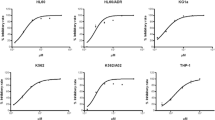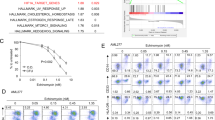Abstract
Leukemia stem cells (LSCs) are considered to be the root of relapse for acute myeloid leukemia (AML). Conventional chemotherapeutic drugs fail to eliminate LSCs. Therefore, new therapeutic strategies eliminating LSCs are urgently needed. Our results showed that low-dose Triptolide (TPL) enhanced the anti-AML activity of Idarubicin (IDA) in vitro against LSC-like cells (CD34 + CD38- KG1αand CD34 + CD38- kasumi-1 cells) and CD34+ primary AML cells, while sparing normal cells. Inspiringly, the combination treatment with low-dose TPL and IDA was also effective against CD34 + blasts from AML patients with FLT3-ITD mutation, which is an unfavorable risk factor for AML patients. Moreover, the combination of TPL and IDA induced a remarkable suppression of human leukemia growth in a xenograft mouse model. Mechanistically, the enhanced effect of low dose TPL on IDA against LSCs was attributed to inhibiting DNA damage repair response. Thus, our study may provide a theoretical basis to facilitate the development of a novel LSCs-targeting strategy for AML.
Graphical abstract






Similar content being viewed by others
References
De Kouchkovsky, I., & Abdul-Hay, M. (2016). Acute myeloid leukemia: A comprehensive review and 2016 update. Blood Cancer Journal, 6, e441.
Daniel, T., & Ravindra, M. (2017). Biology and relevance of human acute myeloid leukemia stem cells. Blood, 129(12), 1577–1585.
Kassim, A. A., & Savani, B. N. (2017). Hematopoietic stem cell transplantation for acute myeloid leukemia: A review. Hematology/Oncology and Stem Cell Therapy, 10, 245–251.
Chatterjee, N., & Walker, G. C. (2017). Mechanisms of DNA damage, repair, and mutagenesis. Environmental and Molecular Mutagenesis, 58(5), 235–263.
Woods, D., & Turchi, J. J. (2013). Chemotherapy induced DNA damage response. Cancer Biology & Therapy, 14(5), 379–389.
Tian, H., Gao, Z., Li, H. Z., Zhang, B. F., Wang, G., Zhang, Q., et al. (2015). DNA damage response – A double-edged sword in cancer prevention and cancer therapy. Cancer Letters, 358, 8–16.
Colomer, C., Margalef, P., Villanueva, A., Vert, A., Pecharroman, I., Solé, L., et al. (2019). IKKα kinase regulates the DNA damage response and drives chemo-resistance in cancer. Molecular Cell, 75(4), 669–682.e5.
Biechonski, S., Yassin, M., & Milyavsky, M. (2017). DNA-damage response in hematopoietic stem cells: An evolutionary trade-off between blood regeneration and leukemia suppression. Carcinogenesis, 38(4), 367–377.
Delia, D., & Mizutani, S. (2007). The DNA damage response pathway in normal hematopoiesis and malignancies. International Journal of Hematology, 106(3), 328–334.
Dartsch, D. C., & Gieseler, F. (2007). Repair of idarubicin-induced DNA damage: A cause of resistance? DNA Repair, 6, 1618–1628.
Li, H., Li, L., Mei, H., Pan, G., Wang, X., Huang, X., Wang, T., Jiang, Z., Zhang, L., & Sun, L. (2020). Antitumor properties of triptolide: Phenotype regulation of macrophage differentiation. Cancer Biology & Therapy, 21(2), 178–188.
Noel, P., Von Hoff, D. D., Saluja, A. K., Velagapudi, M., Borazanci, E., & Han, H. (2019). Triptolide and its derivatives as cancer therapies. Trends in Pharmacological Sciences, 40(5), 327–341.
Zhao, H., Shi, P., Deng, M., Jiang, Z., Li, Y., Kannappan, V., et al. (2016). Low dose triptolide reverses chemoresistance in adult acute lymphoblastic leukemia cells via reactive oxygen species generation and DNA damage response disruption. Oncotarget, 7(51), 85515–85528.
Huang, G., Hu, H., Zhang, Y., Zhu, Y., Liu, J., Tan, B., et al. (2019). Triptolide sensitizes cisplatin-resistant human epithelial ovarian cancer by inhibiting the phosphorylation of AKT. Journal of Cancer, 10(13), 3012–3020.
Chen, F., Liu, Y., Wang, S., Guo, X., Shi, P., Wang, W., et al. (2013). Triptolide, a Chinese herbal extract, enhances drug sensitivity of resistant myeloid leukemia cell lines through downregulation of HIF-1α and Nrf2. Pharmacogenomics, 14(11), 1305–1317.
Yang, Q., Chen, K., Zhang, L., Feng, L., Fu, G., Jiang, S., Bi, S., Lin, C., Zhou, Y., Zhao, H., Chen, X. L., Fu, G., & Xu, B. (2019). Synthetic lethality of combined AT-101 with idarubicin in acute myeloid leukemia via blockade of DNA repair and activation of intrinsic apoptotic pathway. Cancer Letters, 461, 31–43.
Liu, Y., Chen, F., Wang, S., Guo, X., Shi, P., Wang, W., et al. (2013). Low-dose triptolide in combination with idarubicin induces apoptosis in AML leukemic stem-like KG1a cell line by modulation of the intrinsic and extrinsic factors. Cell Death & Disease, 4, e948.
Pollyea, D. A., & Jordan, C. T. (2017). Therapeutic targeting of acute myeloid leukemia stem cells. Blood, 129(12), 1627–1635.
Bruserud, Ø., Aasebø, E., Hernandez-Valladares, M., Tsykunova, G., & Reikvam, H. (2017). Therapeutic targeting of leukemic stem cells in acute myeloid leukemia – The biological background for possible strategies. Expert Opinion on Drug Discovery, 12(10), 1053–1065.
Shlush, L. I., Mitchell, A., Heisler, L., Abelson, S., Ng, S. W. K., Trotman-Grant, A., et al. (2017). Tracing the origins of relapse in acute myeloid leukaemia to stem cells. Nature, 547, 104–108.
Bernasconi, P., & Borsani, O. (2019). Targeting Leukemia Stem Cell-Niche Dynamics: A New Challenge in AML Treatment. Journal of Oncology, 2019, 8323592.
Hosokawa, M., Tanaka, S., Ueda, K., Iwakawa, S., & Ogawara, K. I. (2019). Decitabine exerted synergistic effects with oxaliplatin in colorectal cancer cells with intrinsic resistance to decitabine. Biochemical and Biophysical Research Communications, 509(1), 249–254.
Lyu, M., Liao, H., Shuai, X., **, Y., Su, J., & Zheng, Q. (2020). The prognosis predictive value of FMS-like tyrosine kinase 3-internal tandem duplications mutant allelic ratio (FLT3-ITD MR) in patients with acute myeloid leukemia detected by GeneScan. Gene, 726, 144195. https://doi.org/10.1016/j.gene.2019.144195.
Pratz, K., Rudek, M., Smith, B., Karp, J., Gojo, I., Dezern, A., Jones, R., Greer, J., Gocke, C., Baer, M., Duong, V., Rosner, G., Zahurak, M., Wright, J., Emadi, A., & Levis, M. (2019). A prospective study of peri-transplant sorafenib for FLT3-ITD AML patients undergoing allogeneic transplantation. Biology of Blood and Marrow Transplantation, 26, 300–306. https://doi.org/10.1016/j.bbmt.2019.09.023.
Zhang, C., Lam, S., Leung, G., Tsui, S.-P., Yang, N., Ng, N., et al. (2019). Sorafenib and omacetaxine mepesuccinate as a safe and effective treatment for acute myeloid leukemia carrying internal tandem duplication of Fms-like tyrosine kinase 3. Cancer., 126, 344–353. https://doi.org/10.1002/cncr.32534.
Beeharry, N., Landrette, S., Gayle, S., Hernandez, M., Grotzke, J. E., Young, P. R., et al. (2019). LAM-003, a new drug for treatment of tyrosine kinase inhibitor-resistant FLT3-ITD-positive AML. Blood Advances, 3(22), 3661–3673.
Moloney, J. N., & Cotter, T. G. (2018). ROS signalling in the biology of cancer. Seminars in Cell & Developmental Biology, 80, 50–64.
Hong, M., Li, J., Li, S., & Almutairi, M. M. (2019). Acetylshikonin Sensitizes Hepatocellular Carcinoma Cells to Apoptosis through ROS-Mediated Caspase Activation. Cells, 8(11), 1466.
Hosoya, N., & Miyagawa, K. (2014). Targeting DNA damage response in cancer therapy. Cancer Science, 105, 370–388.
Das, S., Camphausen, K., & Shankavaram, U. (2019). Pan-cancer analysis of potential synthetic lethal drug targets specific to alterations in DNA damage response. Frontiers in Oncology, 9, 1136.
Ma, M., Rodriguez, A., & Sugimoto, K. (2019). Activation of ATR-related protein kinase upon DNA damage recognition. Current Genetics, 66, 327–333.
Rothkamm, K., Barnard, S., Moquet, J., Ellender, M., Rana, Z., & Burdak-Rothkamm, S. (2015). DNA damage foci: Meaning and significance. Environmental and Molecular Mutagenesis, 56(6), 491–504.
Zhang, Y., & Hunter, T. (2014). Roles of Chk1 in cell biology and cancer therapy. International Journal of Cancer, 134(5), 1013–1023.
Luo, Q., Guo, H., Kuang, P., Cui, H., Deng, H., Liu, H., Lu, Y., Wei, Q., Chen, L., Fang, J., Zuo, Z., Deng, J., Li, Y., Wang, X., & Zhao, L. (2018). Sodium fluoride arrests renal G2/M phase cell-cycle progression by activating ATM-Chk2-P53/Cdc25C signaling pathway in mice. Cellular Physiology and Biochemistry, 51, 2421–2433. https://doi.org/10.1159/000495899.
Availability of Data and Materials
The datasets used and/or analyzed during the current study are available from the corresponding author on reasonable request.
Funding
This work was financially supported by National Nature Science Foundation of China, PR China (Grant No.81570156, No.81570425, No. 81770126 and N0. 81700156). Prof. Pengcheng Shi, Young Scientists Fund (No. 81700156). Prof. Bing Xu, National Natural Science Foundation of China (No.81570156, No.81570425, No. 81770126).
Author information
Authors and Affiliations
Contributions
Conception and design: Pengcheng Shi, Jie Zha, Juan Feng, Yirong Jiang, Haihan Song, Bing Xu. Acquisition, analysis and interpretation of data: Pengcheng Shi, Jie Zha, Juan Feng, Bing Xu. Development of methodology: Pengcheng Shi, Jie Zha, Juan Feng, Zhiwu Jiang, Haijun Zhao. Primary samples collection and purification and validation: Pengcheng Shi, Manman Deng, Naying Liao. Animal model analysis and data collection: Pengcheng Shi, Zhiwu Jiang, Peng Li. Writing, and revision of the manuscript: Pengcheng Shi, Jie Zha, Juan Feng, Yirong Jiang, Haihan Song, Bing Xu. Supplemental experiments: Pengchengshi and Jie zha. Response to reviewers: Pengchengshi, Jiezha and Bing Xu.
Corresponding authors
Ethics declarations
Conflict of Interest
The authors declare that they have no conflict of interest.
Ethics Approval
This study was carried out in accordance with the Declaration of Helsinki, and approved by the Ethics Review Board of Nanfang Hospital.
Consent to Participate
Bone marrow aspirates of AML patients and peripheral blood of healthy donors were obtained with the informed consent for research purposes.
Consent to Publish
Not applicable.
Additional information
Publisher’s Note
Springer Nature remains neutral with regard to jurisdictional claims in published maps and institutional affiliations.
Electronic supplementary material
ESM 1
(DOCX 25 kb)
Rights and permissions
About this article
Cite this article
Shi, P., Zha, J., Feng, J. et al. Low-Dose Triptolide Enhanced Activity of Idarubicin Against Acute Myeloid Leukemia Stem-like Cells Via Inhibiting DNA Damage Repair Response. Stem Cell Rev and Rep 17, 616–627 (2021). https://doi.org/10.1007/s12015-020-10054-1
Accepted:
Published:
Issue Date:
DOI: https://doi.org/10.1007/s12015-020-10054-1




